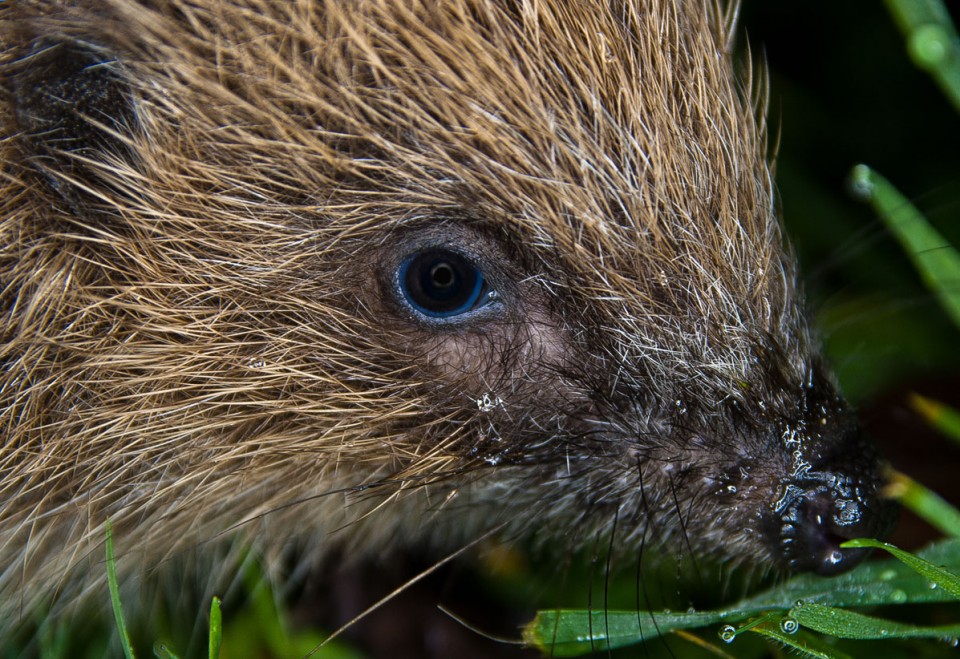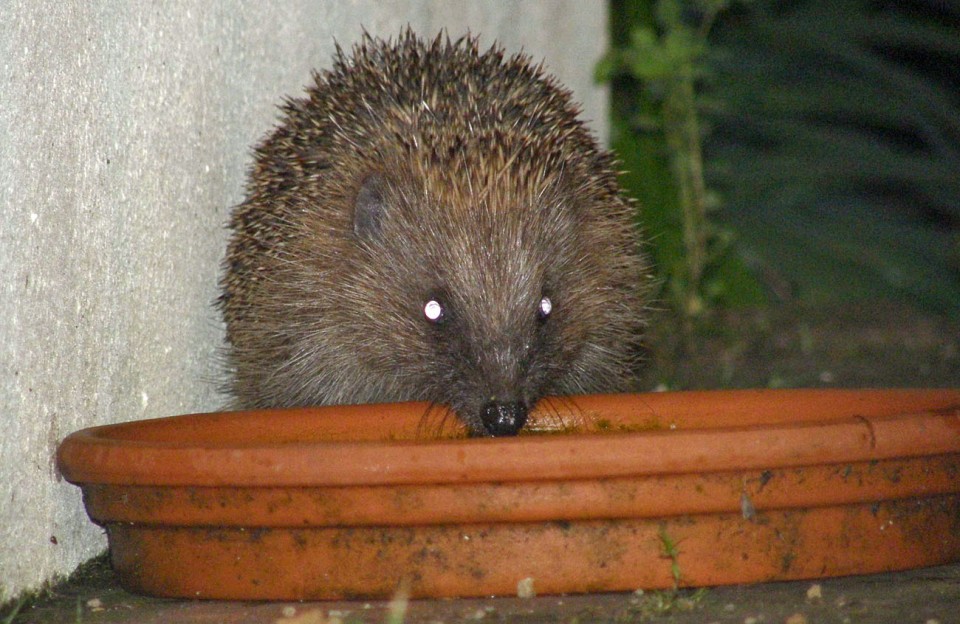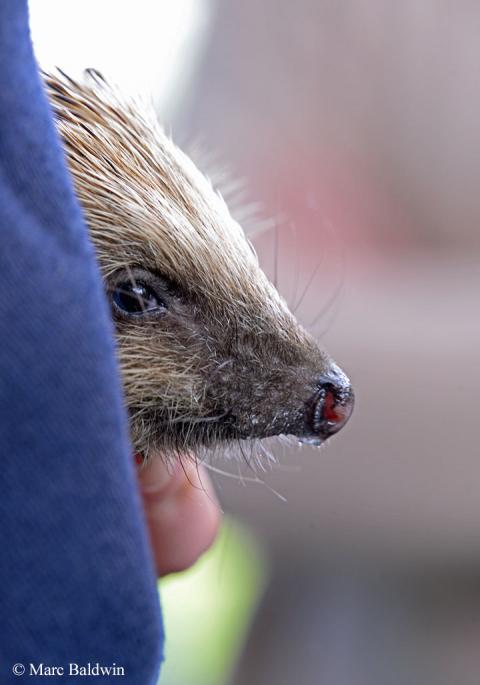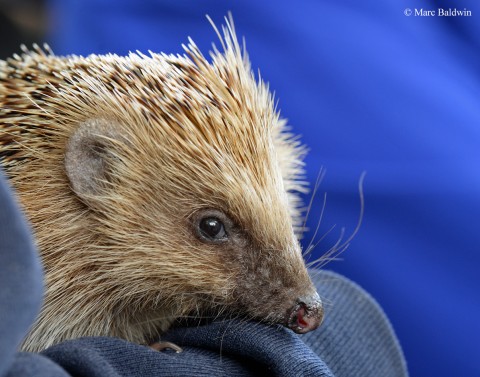European Hedgehog Senses & Vocalisation
Vision
Vision is probably not of the utmost importance to hedgehogs. Their ecological niche of moving around in often tall vegetation at night probably makes vision largely redundant. Indeed, during a study of supplemental feeding of hedgehogs published in Mammal Review during 1985, Pat Morris tracked a virtually-blind male hedgehog that, despite the occasional collision with objects in his path, lived an otherwise normal life. In an environment of twigs and brambles the large eyes sported by nocturnal mammals such as bush babies (Galagidae) would be a liability and it follows that they probably do not have exceptional eyesight. Furthermore, as is the case for most nocturnal animals, colour vision is probably of little consequence to them.

A retinographic study published in the journal Vision Research during 1973 reported that hedgehogs, in common with virtually all other land animals, have a rod-dominated monochromatic retina containing rhodopsin (the visual pigment in rod cells) with a peak sensitivity of about 500 nanometres, in the blue part of the electromagnetic spectrum. The rod cells are moderately-sized and presumably impart sufficient scotopic (low light) vision for the hedgehog to distinguish shapes and moving objects in moonlight. Indeed, in his 2014 revision of Hedgehogs, Pat Morris noted:
“Hedgehogs certainly aren't blind; their little black eyes can spot your approach in the dark from a fair distance away. Hedgehogs also learn to recognise major landmarks like trees and houses. Probably these register as distinctive shapes silhouetted against the sky.”
The paper made no mention of cone (colour-sensing) cells on the retina, but, in his 1965 Hedgehogs: A Comprehensive Study, Konrad Herter noted that about 4% of the hedgehog retina is made up of cone cells. (Humans and other primates, for comparison, are closer to 25% cones.) Herter described how he could train his captive hedgehogs to distinguish yellow from shades of blue and grey suggesting that, in good light conditions, they may have the potential for limited colour vision. A study by Ronald Douglas and Glen Jeffrey published in the Proceedings of the Royal Society B in 2014 found that hedgehog lenses transmitted a significant amount of UVA light, suggesting they may have vision in the UV spectrum despite lacking a specific UV pigment.

Most nocturnal mammals have a layer of reflective cells behind the retina called a tapetum lucidium, from the Latin meaning 'bright tapestry'. These cells reflect light back into the eye, rather than letting it pass through the retina and be lost—the result is that low-light vision is significantly enhanced. It's the eyeshine that we see when we catch deer, foxes, cats and so forth in the beam of a torch or car headlights. In an anonymous paper to The Edinburgh New Philosophical Journal in 1829, the author wrote:
“The tapetum occurs in carnivora, ruminantia, pachydermata, cetacea, owls, crocodiles, snakes, rays and sharks: it is wanting in man, apes, glires, chiroptera, hedgehog and moles; in birds, with exception of owls; and in osseous fishes.”
My experience suggests otherwise as I have frequently observed eyeshine in hedgehogs, both in trailcam videos and flash photographs, suggesting the presence of a tapetum. I have been unable, however, to find any reference to this in the literature.
Smell & touch

Observations on hedgehog olfactory sensitivity have suggested that smell probably plays an important role in their reproduction and sociality—I say “probably” because, although we know hedgehogs have a keen sense of smell and sniff the air constantly, there have been very few rigorous studies into the role scent plays in the lives of any hedgehog species. It has been my experience, however, that male hedgehogs often make a beeline to attack other boars, or court females, several meters away in the pitch black, which suggests to me that they have caught the scent of the conspecific. Perhaps the most telling sign that scent is of importance to hedgehogs can be seen in their morphology; they have a long snout with a large moist tip (called a rhinarium). In conjunction with olfaction, it seems that much of the hedgehog's sense of tactility (touch) is concentrated around the face and in the long guard hairs that fringe its spines.
Internally, Nigel Reeve notes that the brain of these animals possesses well-developed olfactory lobes. Additionally, hedgehogs have a well-developed vomeronasal organ (VON, sometimes referred to as Jacobson's organ), which is comprised of a pair of blind-ending sacs, connected via ducts to the mouth and nasal cavity—most vertebrates have a VON, which feeds its sensory input into the accessory olfactory bulbs. While the function of the VON in humans remains something of a mystery, in other animals it seems to be involved in the sampling of scents—the flicking of a snake's tongue, the rapid tongue movements and drawing back of the lips by ungulates and big cats (referred to as “flehmen”) are some of the best examples. Among the molecules capable of being detected by this organ, are steroid (i.e. sex) hormones. The function of the VON has not been conclusively demonstrated in hedgehogs, but some biologists consider it probable that it plays a role in analysing reproductive pheromones and it has been implicated in self-anointing.
The nose is always wet and in The Hedgehog, Maurice Burton suggests that there may be an “over moistening” when a stranger is present. Burton's observations, triggered by a couple of letters he received from people with captive hedgehogs, indicate that when a hedgehog is confronted by a stranger it “puts up its spines, particularly those above the head, at the same time as the nose drips”. According to the accounts sent to Burton, at least some captive hedgehogs have shown an ability to recognise when a stranger has entered the house; even if they were in another room, the hedgehog's nose apparently started to drip whenever a stranger arrived. I have observed this too, with a hand-reared hedgehog at the British Wildlife Centre in Surrey. When the animal is brought out for the talk and placed on the ground to wander around while visitors are told a bit about hedgehogs, the animal has a moist, but not unusually damp, nose. When the hedgehog is subsequently picked up for the 'close encounter' part of the talk and a crowd of strangers gather around, her nose invariably starts dripping; this continues for the first minute or so of the session. We know from studies of mammal olfaction that moisture helps dissolve airborne scent molecules, thereby improving the animal's sense of smell; generally speaking, the wetter the better. Such accounts suggest that smell is probably an important sense for the hedgehog.
Although poorly studied, the presence of sexual accessory glands and proctodaeal glands suggest that scent may have an important role in sexual behaviour and perhaps also to help individuals recognise each other. According to Walter Poduschka in his 1977 review of insectivore communication, males mark the ground, and perhaps the female, with odiferous secretions exuded from the penis tip through these accessory glands. Similarly, proctodeal glands are sebaceous glands, about 7mm long and 5mm wide (one-third by one-fifth of an inch), located just inside the anus that may add scent to the faeces. Burton notes that hedgehogs have sweat glands on their stomach (none on their back), although it's unknown whether these have a role in scent-marking - if they extend onto the underside of the chin, they may be employed in the hedgehog's curious chin-wiping behaviour.
Reeve also notes that, to the exclusion of the large multi-lobed sebaceous glands in the corners of the mouth and the Meibomian (eyelid) glands, hedgehogs have very few specially developed skin glands. Considering that many of the scent glands found on mammals are involved in marking territory, as much as providing information as to the fitness of the individual who secretes it, it is perhaps not surprising that fewer skin glands are to be found in a non-territorial species like the hedgehog. Nonetheless, I am reasonably sure that hedgehogs use smell to recognise each other an identify potential competition. On several occasions I have seen a boar break away from courting a sow to fight with another boar who is more than a metre away in the dark. Given their relatively small eyes and presume poor eyesight, and that the interloper was sat still making no apparent vocalisations, it seems a reasonable assumption that the courting boar smelt the competitor.
Hearing
We have no data on the importance of sound to hedgehogs, but studies have been undertaken to establish thresholds. Nigel Reeve notes how hedgehogs flinch when keys are jangled or tongues are ‘clicked’ near them, which implies that they probably hear in the ultrasonic (20kHz and above) – anyone who owns a bat detector can testify to the horrible metallic grating that keys make when jangled near it. On my Bat MKII detector, tongue clicking seems sharpest and loudest at around 42 to 45 kHz and barely discernible above 50 kHz; this fits well with the hearing frequency figure of 45 kHz quoted by Les Stocker in The Complete Hedgehog.
Studies looking at hedgehog species other than E. europaeus suggest hearing between 8 and 85 kHz, with a peak at 20 kHz. In their 1969 paper to Journal of Auditory Research, Richard Ravizza and his team from Vanderbilt University in Tennessee report that Hemiechinus auritus can hear tones from 250 Hz to 45 kHz, although the peak was at 8 kHz and at 42 kHz the discrimination was only 2.5%; extrapolating from the audiogram, the biologists concluded that this species can probably hear up to about 60 kHz. Ravizza and his colleagues wrote:

“In comparison to the opossum, the hedgehog is measurably more sensitive throughout most of its [auditory] range but is, nevertheless, less sensitive than most other mammals.”
For comparison, humans can hear within a range of about 20 Hz - 20 kHz (depending on age), dogs 30 Hz - 45 kHz, cats 45 Hz - 65 kHz, and bats 2 kHz - 110 kHz.
In his Frequency Hearing Ranges in Dogs and Other Species article, Louisiana State University neuroscience professor George Strain lists “hedgehog” as hearing in the range of 250 Hz to 45 kHz, although no species or specific reference is given for the value (judging by the range, this is probably Raviza's study). Finally, in his paper on the middle ear anatomy of fossorial (burrowing) and non-fossorial mammals, Matthew Mason at St. Catherine's College in Cambridge, reported that E. europaeus has a smaller pars tensa (tympanic membrane) and an otic cavity volume that's less than half that of their H. auritus specimen, despite their specimen of E. europaeus being larger. The larger tympanic membrane (the membrane that closes the middle ear off from the outside world) in H. auritus may allow this species to hear lower frequencies than E. europaeus.
Sound production
We tend to consider hedgehog to be non-vocal or at best episodically vocal animals. In other words, they don't really produce sound as a means of communicating with one another. This doesn't, of course, mean that they don't make or use sounds. Indeed, hedgehogs produce several different noises, including the “twittering” of hoglets and the “shrill piping [metallic] whistles” (at around 8 kHz) of nestlings. Others include “clucking” or “quacking” when annoyed, various snorts or huffs, spits, and (perhaps) ultrasonic “clicks”. Huffing or snorting is probably the sound that most hedgehog-watchers are familiar with, and this is probably heard most often during courtship. Under most circumstances, the female huffs to show her distain at the attentions of the male. Huffing is not always associated with courtship, however. It may accompany fights between males, and we have observed several encounters where one hedgehog was apparently huffing at another feeding a metre (3 ft.) or more away, despite it showing no discernible interest in the “huffer”. To my ear, the huffing/snorting in all thee circumstances sounds the same.
Interestingly, Walter Poduschka has suggested that hedgehogs may use the ultrasonic clicks to echolocate as has been suggested for some other insectivores. Bats are well known to use echolocation to catch their prey and, in his 1962 Ph.D. thesis at Tulane University in Louisiana, Edwin Gould presented data suggesting that shrews may be capable of echolocation. To the best of my knowledge, echolocations has never been conclusively demonstrated in hedgehogs.
A female hedgehog shorting during courtship. Hedgehog courtship involves the male persistently circling the female while she turns to face him snorting every second or so. The male's circling, and the female's snorting, can continue uninterrupted for an hour or more. - Credit: Marc Baldwin
The "quacking" noise made by a hedgehog when annoyed. This vocalisation may be accompanied by bristling spines. - Credit: Natasha Harper
A hedgehog snorting and quacking/clucking while backing away from another individual. - Credit: Steph Powley
A hoglet, a couple of weeks old, calling for its mum. This loud, sharp squeak is made by hoglets while still in the nest. - Credit: Jayne Morgan
During aggressive encounters, such as agonistic displays and fights, male hedgehogs make a loud, rasping snorting noise. - Credit: Steph Powley
There are also noises made by hedgehogs that require further investigation as they typically indicate distress. These include, but are not limited to, coughing, squeaking and wheezing and should be assessed by a qualified rescue or vet. While a coughing or wheezing hedgehog will often require treatment, a heavy lungworm infection that has cleared can leave otherwise healthy hedgehogs with a permanent wheeze or whistle, and rescues may not always advise capture. It is also not uncommon for hedgehogs to sneeze while feeding, particularly on dry kibble/biscuits. This appears to be a response to either the dust from the food or eating too rapidly; possibly a combination of the two.
This is a curious "metalic" sounding noise and may, in some cases, be associated with annoyance. Again, persistent coughing should always be investigated by a vet. - Credit: Jo Mason
A "wet" cough made by a hedgehog suffering from lung parasites. Hedgehogs making this noise require veterinary attention - Credit: Jayne Morgan
A squeaky-wheeze made by a hedgehog in distress. This animal appeared to be suffering from a nasal/sinus obstruction. As with the cough above, hedgehogs making such squeaking/wheezing noises should be assessed by a qualified rescue or vet. - Credit: Mel Kane
Perhaps the sound every hedgehog keeper fears most is “the scream”. In Hedgehogs, Reeve mentions that he's never heard wild hedgehogs scream, although it is fairly well documented in the literature. The documentary Hedgehog Hotel, broadcast on ITV during 2015, described the sound of the scream as “akin to cats fighting”. In an online article about hedgehog vocal repertoires, hog keeper Mike McGary wrote:
“My young male (Adam) has been known to scream when frightened. This isn't a small squeak, but a full-fledged rabbit-caught-in-a-trap scream.”
The experiences of hedgehog owners suggest that screams aren't necessarily related to fear or danger. On the Hedgehog Central discussion boards, one member wrote:
“The hedgie scream of death will make your blood curdle. ... Emma did it one time when HORRORS, we rearranged her cage on her and she was royally pee'd off about it. Pebbles got a nail caught in her blankie as she was trying to leave her igloo and of course she couldn't go too far. Their room is on the second level of the house and everyone in all parts of the house heard her and came running wondering what was wrong. We all thought for sure she was being killed.”
This suggests that frustration may be a cause of the scream, at least in some captive individuals, although screaming may not always accompany frustration. In The Hedgehog, for example, Maurice Burton described an incident in which a hedgehogs tried to find its way through some wire netting and, when it couldn't locate an opening, dashed at it, seized it in its teeth and tugged at it “in apparent rage” and, when nothing gave way, the hog “threw itself on the ground on its back and writhed around as if in a tantrum”.
Burton does not make any mention of the hedgehog screaming. He does, nonetheless, recount an incident of a hoglet following a gentleman in his garden: when the man stopped the hoglet would lay down next to his shoes and whenever he started moving again the hoglet “screamed with rage, ran after him and again settled near his shoes”. Burton suggested this was shade-seeking behaviour and the hoglet was frustrated at the movement of its shady spot, although it does raise the question of whether the hoglet had imprinted on the gentleman's shoes? Several years ago, however, a colleague of mine told me how she had been watching a female hedgehog with a group of hoglets in her garden and when one hoglet became separated from the group it started screaming until it was reunited.
In some cases screaming may be a response to being pestered by male. In June 2017, Paul Hurle recorded what appears to have been a hedgehog screaming outside his house in Hampshire in the early hours of the morning (below). On listening the to the clip, Happy Hedgehog Rescue founder Jayne Morgan told me some of her patients make the same noise when being hassled by a male:
“I have a female here that screams like that when a male isn't even touching her. I rush out in a panic and she just screams to scare him away. ... I've caught mine twice recently and she wasn't happy but on both occasions male was circling but not touching.”
A hedgehog distress call. (The repeated tick in the background is a clock.) - Credit: Paul Hurle
An aggressive distress call made by a hedgehog upon approach by a badger. The badger did not flinch, ate food next to the hedgehog and then left. The hedgehog didn't scream again and continued feeding after the badger had left. - Credit: Alan Baldry
Jayne went on to explain that this “unusual repeated wail” was different to the one hedgehogs make when being attacked by a predator, such as a badger. In his 1950 book Wild Animals in Britain, Oliver Pike wrote:
“The usual cry is a loud short squeak, rather high pitched, which must not be confused with the wild scream when defeated in a tussle with a fox.”